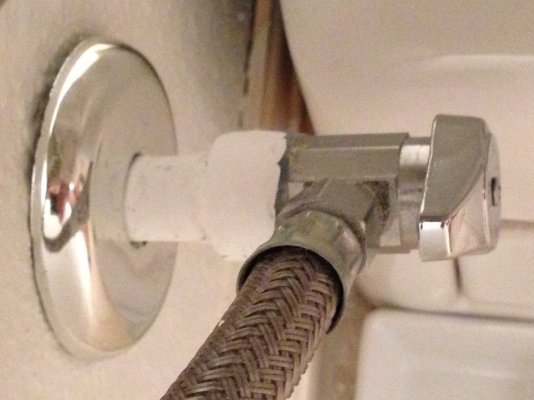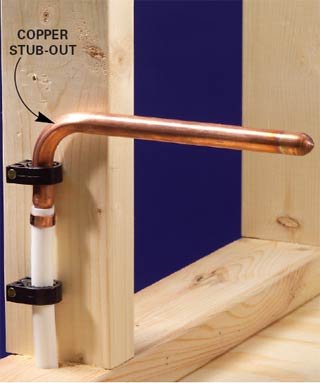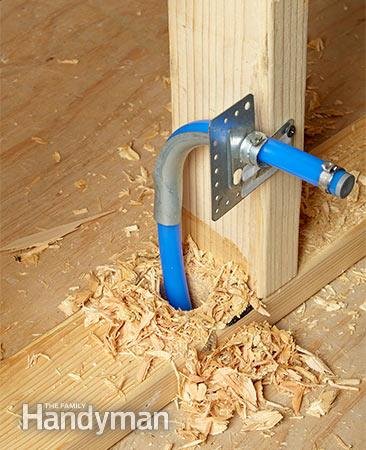Plumbers re-piped the house's galvanized pipes with PEX. Ran a PEX stub out for the toilet supply and put a valve on it. 6 months later, the valve leaks. I want to replace the fitting with a sharkbite connector, but I don't know how to remove the existing fitting. Is it crimped to the PEX out of the wall such that it has to be cut off, like a compression fitting? Or is there some way to release the valve? See photo. I painted the PEX and fitting white so it would blend in better (and to protect the PEX from UV degradation).
You are using an out of date browser. It may not display this or other websites correctly.
You should upgrade or use an alternative browser.
You should upgrade or use an alternative browser.
How do I remove this plumbing valve?
- Thread starter soupcxan
- Start date
- Joined
- Oct 13, 2010
- Messages
- 10,735
Typically a pex crimp ring is crimped about 1/8 inch from the valve body. But I don't see a crimp ring in the photo. If that really is pex coming out of the wall, then you should be able to cut the tube on the wall side of the crimp ring and yank the valve off the tube. You would be in trouble, though, if that left you with a stub that was too short to get the crimp tool in there to crimp on the new valve.
1) The Pex could be attached to a brass or plastic fitting that screws into the valve. If so, you can unscrew it. This is an unlikely setup.Plumbers re-piped the house's galvanized pipes with PEX. Ran a PEX stub out for the toilet supply and put a valve on it. 6 months later, the valve leaks. I want to replace the fitting with a sharkbite connector, but I don't know how to remove the existing fitting. Is it crimped to the PEX out of the wall such that it has to be cut off, like a compression fitting? Or is there some way to release the valve? See photo. I painted the PEX and fitting white so it would blend in better (and to protect the PEX from UV degradation).
2) The present setup might use a Sharkbite-like fitting, if it is the removeable type, it can be removed by pushing in evenly on the plastic ring and popping out the PEX. If this was installed by a plummer it's unlikely he used a Sharkbite.
3) The most likely situation is that the valve has a male end that goes inside the PEX. The plumber could have expanded the PEX with a special tool ( a "Wirsbo expander") to put it on or, more likely, there's a metal band around the outside of the PEX (a "crimped" copper band or a "cinched" stainless steel clamp around it. If it has a meta clamp, you could just apply a new metal band if you have (or can borrow) the specialized tool. If you want to use a Sharkbite, then I think you'll need to cut off the PEX as close to the fitting as possible and start with PEX that hasn't been expanded/distorted inside the fitting.
Gotta be careful not to cut things off too close to the wall, or your options will be unattractive.
Check to see if there's a way to turn off the water in this PEX line. When plumbers install PEX plumbing, they often install a single manifold with a lot of "home run" lines that go to individual fixtures or rooms. This is a bit like a circuit breaker box for electricity--one place where the water can be turned off to a particular room. Doing things this way is a major advantage of PEX plumbing.
Last edited:
Rustward
Thinks s/he gets paid by the post
- Joined
- Apr 19, 2006
- Messages
- 1,684
Hire a plumber! 

travelover
Give me a museum and I'll fill it. (Picasso) Give me a forum ...
- Joined
- Mar 31, 2007
- Messages
- 14,328
It can be done two ways. If there is a copper stub the valve may have been soldered on. It the Pex is just bend and sticks out of the wall, it is as Samclem said, clamped. In either case, I'd take the valve apart and see if it can be repacked at the stem or have the washer replaced.
Attachments
Senator
Thinks s/he gets paid by the post
I do a fair amount of plumbing on my rentals...
It's pretty easy. Cut the braided stainless steel, then twist the valve while applying an outward pressure. It will 'screw' off. I assume it is on a copper pipe or stub-out.
It appears to be a push on valve. When you get it off, replace it with a quarter turn ball valve, with a compression fitting on the copper.
If it is just a pex valve, cut the pex and re-install a new valve or reinstall the old one valve, if it is the connection that is leaking. It looks like a quarter turn valve already, there is no fixing the valve. You may be able to tighten the clamp, but probably too good enough.
I would try and contact the plumber first, it's their mistake. They might fix it free. I would also stay away from a shark bite fitting. I think that is similar to what you have that is leaking.
Update: After looking at the picture, it's hard to tell if you have a compression valve already, with a separate supply line. It appeared to be a one piece push on in the first look. With the supply line part of the valve.
It's pretty easy. Cut the braided stainless steel, then twist the valve while applying an outward pressure. It will 'screw' off. I assume it is on a copper pipe or stub-out.
It appears to be a push on valve. When you get it off, replace it with a quarter turn ball valve, with a compression fitting on the copper.
If it is just a pex valve, cut the pex and re-install a new valve or reinstall the old one valve, if it is the connection that is leaking. It looks like a quarter turn valve already, there is no fixing the valve. You may be able to tighten the clamp, but probably too good enough.
I would try and contact the plumber first, it's their mistake. They might fix it free. I would also stay away from a shark bite fitting. I think that is similar to what you have that is leaking.
Update: After looking at the picture, it's hard to tell if you have a compression valve already, with a separate supply line. It appeared to be a one piece push on in the first look. With the supply line part of the valve.
Last edited:
latexman
Thinks s/he gets paid by the post
6 months? How long did your plumber warrantee his work? Call them and see.
pb4uski
Give me a museum and I'll fill it. (Picasso) Give me a forum ...
+1 within a year the plumber should cover it.
NW-Bound
Give me a museum and I'll fill it. (Picasso) Give me a forum ...
- Joined
- Jul 3, 2008
- Messages
- 35,712
The OP said the valve was installed on a PEX line, so there is not a copper stub.
He painted over the connection, so I could not make out the crimp ring. But if there is, then it is of the same type as is shown in the following video.
I have not repaired this type, so wonder if it is kosher to carefully cut off the crimp ring (using a Dremel tool), then crimp the new valve on. Would the already compressed PEX hold the new crimp?
How To Install a BrassCraft PEX Valve - YouTube
He painted over the connection, so I could not make out the crimp ring. But if there is, then it is of the same type as is shown in the following video.
I have not repaired this type, so wonder if it is kosher to carefully cut off the crimp ring (using a Dremel tool), then crimp the new valve on. Would the already compressed PEX hold the new crimp?
How To Install a BrassCraft PEX Valve - YouTube
Senator
Thinks s/he gets paid by the post
It depends on if the valve is leaking, or the pex connector. To me, it looks like a push-on valve, not pex at the valve. It’s hard to tell with the paint. Pex at the valve would be very flexible.
Odds are, if it is that easy as removing the pex ring and putting a new one on, you could just re-crimp the original Pex ring.
There are two types of pex rings, a cinch ring, and a copper ring. The cinch ring can be removed with a nippers or wire cutter. The crimp ring needs the pex to be cut, and a special pex ring cutter. A Dremal tool might work to remove it. But I do not see either ring there.
Taking the ring off, and installing a new ring, only works if you have the tools. It also assumes the original valve is not damaged that caused the leak around the pex barbs. A copper ring compression tool is like $80. A cinch ring tool is ~$30, but the rings cost a bit more.
Odds are, if it is that easy as removing the pex ring and putting a new one on, you could just re-crimp the original Pex ring.
There are two types of pex rings, a cinch ring, and a copper ring. The cinch ring can be removed with a nippers or wire cutter. The crimp ring needs the pex to be cut, and a special pex ring cutter. A Dremal tool might work to remove it. But I do not see either ring there.
Taking the ring off, and installing a new ring, only works if you have the tools. It also assumes the original valve is not damaged that caused the leak around the pex barbs. A copper ring compression tool is like $80. A cinch ring tool is ~$30, but the rings cost a bit more.
Similar threads
- Replies
- 0
- Views
- 567



